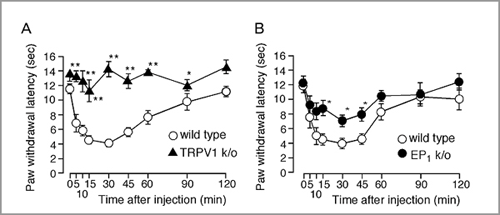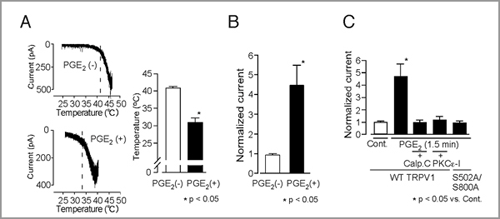プロスタグランジンは炎症時に放出される炎症関連メディエイターの1つで炎症性疼痛発生のキー蛋白質として機能する。現在使われている消炎鎮痛剤の多くはcyclooxygenaseの機能阻害によりプロスタグランジン産生を抑制して働く。本研究では、プロスタグランジンE2 (PGE2)、プロスタグランジンI2 (PGI2)がそれぞれEP1、IP受容体に作用して、Gq蛋白質活性化からPKC依存的にカプサイシン受容体TRPV1をリン酸化してTRPV1の機能増強をもたらすことを明らかにした。PGE2、PGI2あるいはマスタードオイルによる熱性痛覚過敏がTRPV1欠損マウス、EP1欠損マウス、IP欠損マウスで有意に減弱することから、このプロスタグランジンによる痛覚過敏発現にこれらの分子の機能連関が重要であることが個体レベルでも確かめられた。
Moriyama T, Higashi T, Togashi K, Iida T, Segi E, Sugimoto Y, Tominaga T, Narumiya S, Tominaga M. Sensitization of TRPV1 by EP1 and IP reveals peripheral nociceptive mechanism of prostaglandins. Molecular Pain 1:3-12, 2005.

PGE2-induced thermal hyperalgesia was reduced in either TRPV1 k⁄o mice or EP1 k⁄o mice.
A. PGE2-induced thermal hyperalgesia in wild type mice or TRPV1 k⁄o mice.
B. PGE2-induced thermal hyperalgesia in wild type mice or EP1 k⁄o mice. * p < 0.05, ** p < 0.01 vs. wild type.

GE2-increases TRPV1 activity in a PKC-dependent manner in HEK293 cells expressing TRPV1 and EP1 receptors.
A. Temperature threshold for TRPV1 activation was reduced in the presence of extracellular PGE2 (1µM). Representative temperature-response profiles in the absence (upper) and presence (lower) of PGE2 (left). Temperature threshold for TRPV1 activation in the presence of PGE2 (30.6 ± 1.1°C) was significantly lower than that in the absence of PGE2 (40.7 ± 0.3°C) (right). * p < 0.05 vs. PGE2 (-).
B. Proton-evoked TRPV1 responses were significantly potentiated by PGE2 (1µM). * p < 0.01 vs. PGE2 (-).
C. PKC-dependent pathway is involved in the PGE2 (1µM, 1.5 min)-induced potentiation of capsaicin-activated currents. In some experiments, calphostin C (Calp. C) (1µM) or PKCε translocation inhibitor (PKCε-I) (200µM) was included in the pipette solution. * p < 0.05 vs. Cont. Vh: -60 mV.